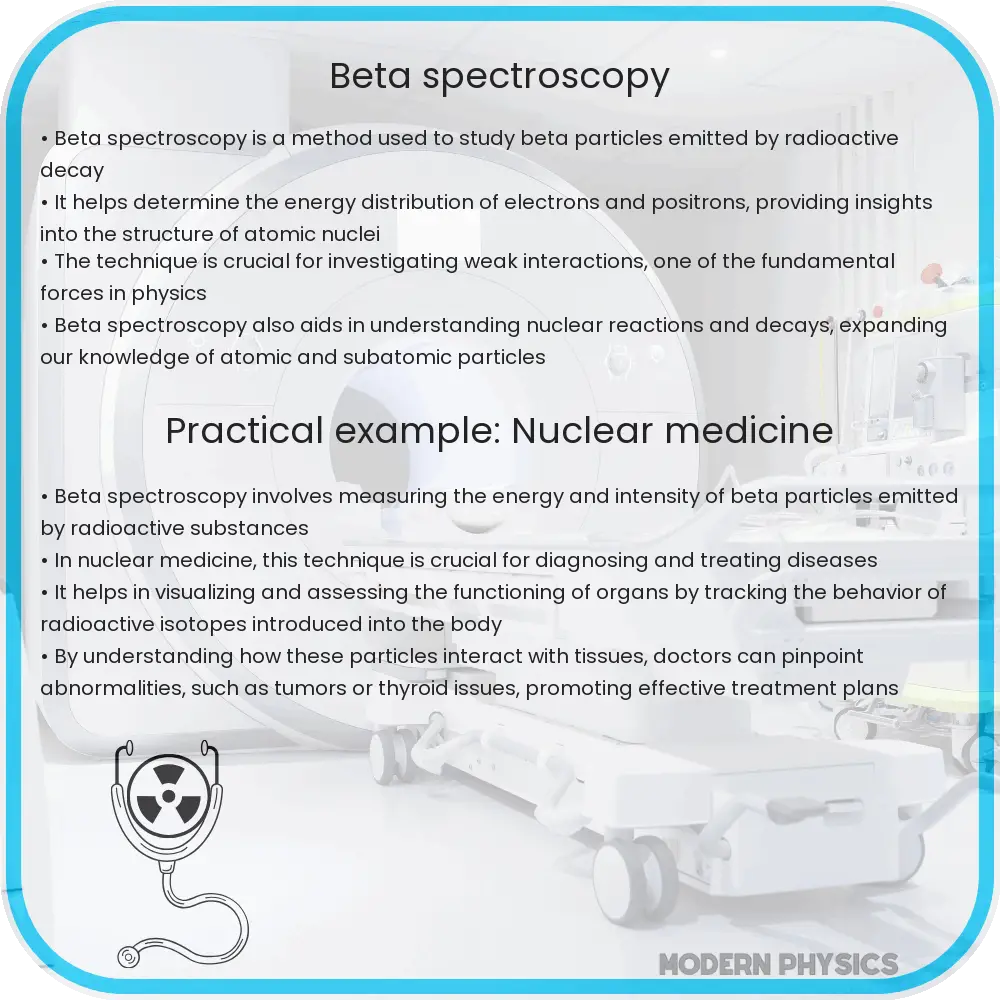Beta spectroscopy analyzes the energy of beta particles from radioactive decay, aiding research in nuclear physics, material science, and more.

Introduction to Beta Spectroscopy
Beta spectroscopy is a powerful analytical technique used in physics to study beta particles – electrons or positrons that are emitted from radioactive decay. This method provides detailed information about the energy spectrum of beta particles and is fundamental in fields such as nuclear physics, material analysis, and environmental science.
The Basics of Beta Decay
Beta decay is a type of radioactive decay in which a nucleus transforms into a different element by emitting a beta particle. There are two types of beta decay: beta-minus (β–) decay, involving the emission of an electron, and beta-plus (β+) decay, involving the emission of a positron. The general equations for these decays are:
- Beta-minus decay: \( n \rightarrow p + e^{-} + \bar{\nu}_{e} \)
- Beta-plus decay: \( p \rightarrow n + e^{+} + \nu_{e} \)
Here, \( n \) and \( p \) denote a neutron and a proton, respectively, \( e^{-} \) and \( e^{+} \) denote an electron and positron, and \( \bar{\nu}_{e} \) and \( \nu_{e} \) denote an electron antineutrino and neutrino, respectively.
How Beta Spectroscopy Works
Beta spectroscopy involves measuring the energy of emitted beta particles to understand the decay process and properties of the nucleus. The technique uses a detector, like a scintillator or a semiconductor detector, to capture and measure the energy of beta particles. The energy data collected forms what is known as a beta spectrum, which helps in identifying the specific type of decay and understanding the nuclear transformation involved.
Types of Beta Spectrometers
There are various types of spectrometers used in beta spectroscopy, each suited to different types of analysis:
- Magnetic Spectrometers: utilize a magnetic field to curve the path of beta particles according to their momentum. By measuring the curvature, the momentum and thus the energy of the particles can be determined.
- Scintillation Detectors: use a material that fluoresces when struck by a beta particle. The amount of light produced is proportional to the particle’s energy, which is then measured to construct the energy spectrum.
- Semiconductor Detectors: involve materials whose electrical properties change when exposed to beta particles. These changes are measured and related back to the energy of the impacting particles.
Practical Uses of Beta Spectroscopy
Beta spectroscopy has practical applications across various fields due to its sensitivity and precision in measuring radiation. Here are some of its key uses:
- Nuclear Physics: To study the properties of radioactive elements and isotopes, understanding the patterns of nuclear decay and the structure of atomic nuclei.
- Medical Sciences: Used in radiopharmaceuticals for both diagnostic and therapeutic purposes, examining the behavior and disposition of beta-emitting isotopes in the human body.
- Environmental Science: In tracking and analyzing pollution, especially for monitoring radioactivity in the environment and assessing contamination levels.
- Material Science: To analyze impurities and defects in materials, as beta particles can be sensitive to small changes in material composition.
Challenges and Limitations of Beta Spectroscopy
While beta spectroscopy is a valuable tool in many scientific fields, it does come with certain challenges and limitations that must be considered:
- Background Radiation: Detecting low levels of beta radiation can be difficult due to background radiation, which may lead to errors in measurement.
- Energy Resolution: The accuracy of energy measurements can be limited by the resolution of the spectrometer being used, affecting the precision of the analysis.
- Detector Efficiency: Not all beta particles emitted from a sample will be detected, as some may escape or not interact effectively with the detector material.
- Sample Preparation: Proper sample preparation is crucial, as contamination or improper handling can skew the results significantly.
Advancements in Beta Spectroscopy
Technological advancements have continuously improved the capabilities of beta spectroscopy. Some of the recent developments include:
- Enhanced Detector Materials: New materials with higher detection efficiency and better energy resolution are being developed, allowing for more precise measurements.
- Digitization of Data Collection: Modern spectrometers are equipped with digital data collection systems that provide faster and more accurate data processing capabilities.
- Automated Systems: Automation in sample handling and data analysis helps in reducing human errors and increasing throughput in laboratories.
In addition, interdisciplinary approaches combining beta spectroscopy with other analytical methods have opened new avenues in research and practical applications, enhancing the overall utility of this technique.
Conclusion
Beta spectroscopy stands as a cornerstone technique in the exploration and analysis of radioactive substances. From its fundamental role in nuclear physics to impactful applications in medical and environmental sciences, this method offers a critical window into the subatomic world. Although it faces specific challenges such as background radiation and detector efficiency, ongoing advancements in technology continue to expand its potential. With improved detection materials and digital enhancements, beta spectroscopy remains a dynamic field, poised to contribute significantly to our understanding of nuclear processes and beyond. As we improve and refine these tools, we can look forward to new discoveries and applications that will further benefit society and deepen our scientific knowledge.
